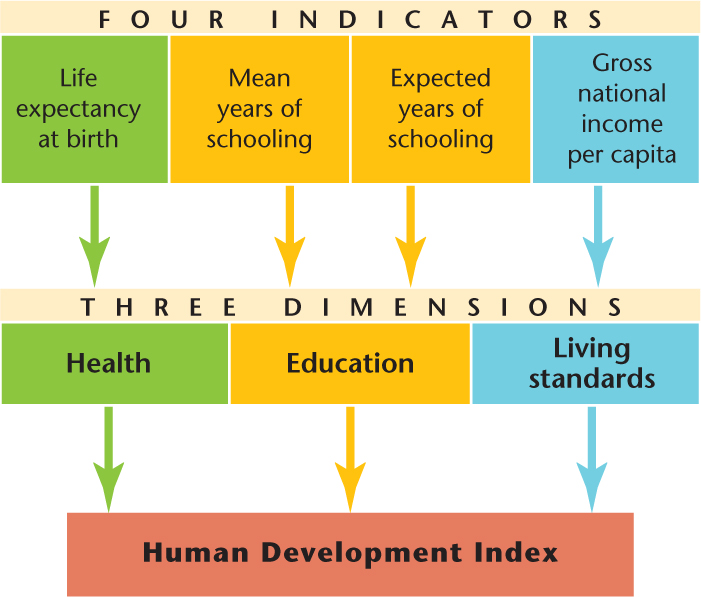What is Economic Development?
What is Economic Development?
economic development The process by which an agricultural society moves toward industrialization and (usually) higher patterns of income.
How can we understand why certain regions of the world are relatively wealthy while other regions of the world are poor? Many of you have had the experience of traveling to countries or regions where the everyday conditions of living seem so much more difficult than the conditions you are used to at home. If you haven’t traveled to these places, you certainly have seen enough television shows, movies, and Internet features to understand that the everyday lives of people in different parts of the world, including their access to housing, food, and health care, may differ greatly from yours. You may also notice that there are economic differences within your own neighborhood, town, or city. On a global scale, the differences between those parts of the world that are considered wealthy and those that are less wealthy often are explained with reference to stages of economic development. In general, economic development refers to the process by which an agricultural society moves toward industrialization and (usually) higher patterns of income.
We’ve discussed the idea of development throughout the book, particularly in Chapter 3, where we examined how development is often correlated with a region’s demographic structure. In this chapter we focus on the economic aspects of development to help explain how and why people living in different parts of the world have differing access to resources such as food, health care, and housing. First, however, it is important to understand exactly what is meant by economic development.
industrialization The transformation of raw materials into commodities or the process by which a society moves from subsistence agriculture toward mass production based on machinery and industry.
The term economic development emerged in the post–World War II era, when scholars and government and policy officials, particularly those in the United States, became concerned that the standard of living in many regions of the world was quite low. By standard of living, they were referring to such things as literacy rates, infant mortality, life expectancy, and poverty levels. They realized that in general a low standard of living was correlated with an economy that was based primarily on subsistence agriculture. These officials and scholars believed that introducing new technologies and skills would enable these regions to develop more productive forms of agriculture and that industrialization—the transformation of raw materials into commodities—would follow. These new economic initiatives then would lead to a higher standard of living. This viewpoint—categorizing regions of the world using the criterion of economic structure and then assuming that transforming economic structure could raise the standard of living in certain regions—is what came to be known as economic development.
gross domestic product (GDP) A measurement of the total value of all goods and services produced within a particular region or country within a set time period.
Today, economic development as a concept refers to two related but somewhat different ideas. The first is a way of categorizing the regions of the world. Regions are categorized according to particular measures of economic growth, such as GDP (gross domestic product). GDP is a measurement of the total value of all goods and services produced within a particular region or country within a set time period. Those regions with relatively high GDPs are considered developed regions; those with relatively low GDPs are considered developing regions (Figure 9.1). The second meaning refers to the actual process of economic growth. It can refer to the shift of a region’s economy from one based on subsistence agriculture to one that relies on industrialization. Thus, economic development refers both to a process and to a way of categorizing the different regions of the world.
Gross Domestic Product

Thinking Geographically
Question 9.1
Compare this map with the human development index map in Figure 1.12. How are the two maps alike? How do they differ?
As we saw in Chapter 1, a measure that geographers commonly use to describe economic development is the Human Development Index (HDI). The HDI measures well-being by way of three categories: health, education, and living standards (Figure 9.2). Each of these dimensions incorporates several indicators, including life expectancy, mean (average) years of schooling, and per capita income. Geographers consider these measures to be important in determining overall quality of life. Unlike GDP, the HDI focuses on the human dimension of development rather than solely on national income. Though it is difficult to describe human well-being using only one composite index, the HDI does provide a basis for comparison between areas of high development, low development, and the extensive continuum in between.

Thinking Geographically
Question 9.2
What difficulties do you think might be involved in accurately calculating the HDI for less developed countries?